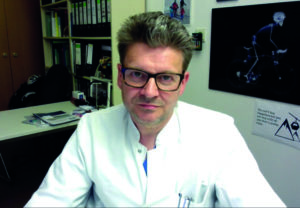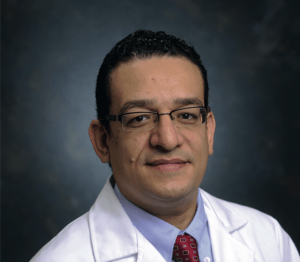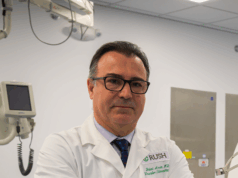This advertorial is sponsored by Sirtex Medical.

Two experts in the field of interventional radiology, Bernhard Gebauer (head of interventional radiology at Charité – Universitätsmedizin Berlin in Berlin, Germany) and Ahmed Kamel Abdel Aal (professor of interventional radiology at The University of Texas Health Science Centre in Houston, USA) talk to Interventional News about their experience with SIR-Spheres Y-90 resin microspheres (Sirtex Medical)—which are used in selective internal radiation therapy (SIRT) for certain liver tumours*—and discuss how this advanced technology can help improve survival, boost patient quality of life (QoL) and enable greater flexibility, customisation and speed of treatment.

Real-world data
Real-world data from the Cardiovascular and Interventional Radiological Society of Europe (CIRSE) Registry for SIR-Spheres Therapy (CIRT)—which was presented at the CIRSE 2020 Summit (12–15 September, virtual)—showed that SIR-Spheres Y-90 resin microspheres were associated with low 30-day mortality (1%) as well as a low incidence (2.5%) of serious adverse events (grade ≥3) within 30 days of treatment. Serious adverse events such as gastritis, gastrointestinal ulcerations, radiation cholecystitis and radioembolization-induced liver disease occurred in less than 0.3% of the total patient cohort.
This large European registry, which included 1,027 patients, was designed to observe the real-life clinical application of SIRT with SIR-Spheres Y-90 resin microspheres and the impact of the treatment in clinical practice. “The strength of CIRT registry data is that they reflect patient and tumour treatment in a real-world scenario, including large treatment centres and smaller hospitals from different countries and healthcare systems,” says Gebauer.
In addition to highlighting low mortality and low serious adverse events, the data also found that median overall survival was 9.8 months (95% CI: 8.3–12.9) in 237 patients with metastatic colorectal cancer (mCRC). These figures from CIRT are “a great result for patients with certain types of cancer who have limited options”, adds Kamel.
Similar findings were reported in the CIRSE Registry for SIR-Spheres Therapy in France (CIRT-FR), the interim analysis of which revealed some interesting data in relation to safety and patient QoL. There were a total of 200 patients (median age 66; 70% male) including 38 mCRC patients in the CIRT-FR registry. As was the case in CIRT, 30-day mortality was 1%. A total of 12% of patients experienced at least one adverse event within 30 days following treatment. In relation to health-related QoL, which was assessed using the EORTC QLQ-C30 questionnaire, the overall global health score remained stable between baseline (66.7%), treatment (62.5%) and the first follow-up (66.7%)
“For heavily pretreated patients, the toxicity of a treatment and QoL are very important”, says Gebauer, adding that “the data show that SIR-Spheres Y-90 resin microspheres are well tolerated and maintain patients’ QoL.” He also explains that, with this technology, patients can be offered a chemo-free interval in order to have the liver treated but without the side effects of a systemic therapy.
Patient selection
Gebauer further discusses which patients can benefit most from this treatment, noting that, in general “SIR-Spheres Y-90 resin microspheres are an option for a broad range of patients.” He also outlines that oncological factors such as tumour size and number of tumours, as well as the functional capacity of the liver “play a great role” in determining the use of SIR-Spheres Y-90 resin microspheres.
“Usually Y-90 treatment using SIR-Spheres is used in patients where the tumours are not resectable or ablatable, either because of tumour factors (tumour too large, adherent to critical organs or structures or invading vascular structures), remaining hepatic reserve limitations (especially if large hepatic resections are planned) or other patient factors or comorbidities that limit larger resections. Specifically, in the first group (tumour factors) Y-90 SIRT could reduce the tumour volume and transfer the patient in a secondary resectable or ablatable state.
“In selected cases, patients might benefit from an earlier treatment with SIRT. SIR-Spheres Y-90 resin microspheres show good response rates in localised liver tumours and offer patients surgical options that were unavailable before SIRT.
“So patients could be transferred into a suitable stage for resection or ablation and transferred into a potentially curative stage. Depending on the location of liver tumours SIRT allows various treatment strategies including segmentectomy, lobectomy and hemiablation with contralateral hypertrophy for resection”, he adds.
“Preinterventional state-of-the-art imaging is essential for therapy planning”, says Gebauer, who adds that “personalised medicine is nowadays the standard of cancer care and therefore the dosimetry should also be so in order to improve the results of SIRT.”
Kamel outlines how it is “important to realise that each disease and each patient is different”. He agrees with Gebauer that, as a result, “treatment should be based on the goal of the therapy, the patient’s liver function, the number and location of the lesions and the prior, concurrent and future treatment(s). Personalised dosimetry is always recommended for all patients receiving Y-90 SIR-Spheres”, he concludes.
Utilisation and customisation
SIR-Spheres Y-90 resin microspheres therapy is a minimally invasive procedure that sees patients usually return home shortly after the procedure is completed. It is currently the only fully US Food and Drug Administration (FDA)-approved Y-90 radiation therapy in the USA for the treatment of colorectal cancer that has spread to the liver. The Y-90 resin microspheres can be delivered in a slow, deliberate manner, thereby helping to achieve an even distribution, thus maximising the number of microspheres delivered and optimising tumour coverage.
Discussing some of the challenges associated with many Y-90 programmes, Kamel states that “outcomes are often variable and not consistent. It can also take some time between the decision for treatment and treatment with Y-90. This can delay other treatments and adds a lot of stress to the patient,” he continues.
However, there is a solution. Helping to address these challenges is Sirtex’s FLEXdose Delivery Programme, which Kamel says has helped optimise his practice. He explains that the FLEXdose Delivery Programme provides physicians with the opportunity to have one-, two- or three-day pre-calibrated vials which contain exactly the same number of microspheres, with different activity per sphere.
“This offers you the flexibility to give the same activity but with either more or fewer microspheres, allowing you the ability to customise treatment based on the tumour burden, lobes and segments of the liver involved, and how selective you are with your catheter,” says Kamel.
“Another advantage is the activity draw, which is really very important in our programme and is very unique to SIR-Spheres. It allows you to administer a tailored and personalised activity for the patient’s specific needs. Imagine that on the day of treatment you wanted a smaller dose or another dose. You can draw the exact dose that you desire from the vial. Being able to change the dose on the day of the treatment means you do not have to keep bringing the patient back again because you do not have the right dose.”
“Previously, the usual sequence of events was to map, do the dose calculation, order the dose and then treat,” notes Kamel. “However, utilising Sirtex’s Order-Map-Treat programme, you get a much faster patient treatment.”
“We know that we can always draw the exact dose we want and that is the beauty of this. It has also really changed the mindset of our referring physicians because we can provide an accelerated treatment timeline that enables patients to be quickly returned to their medical oncologists for further systemic treatment(s)”, concludes Kamel.
*For full indication and prescribing information, please refer to the IFU at www.sirtex.com.
Bernhard Gebauer is head of interventional radiology at Charité – Universitätsmedizin Berlin in Berlin, Germany. He is German board certified in radiology and interventional radiology and specialised in IR cancer treatment.
Ahmed Kamel Abdel Aal is a professor of interventional radiology and the chief of vascular and interventional radiology and the vice chair of radiology at The University of Texas Health Science Center at Houston (UTHealth) in Houston, USA. He is American board certified in radiology and interventional radiology and received his fellowship training in vascular and interventional radiology as well as neuroradiology at the University of Alabama in Birmingham, USA.













